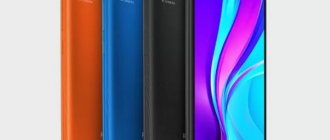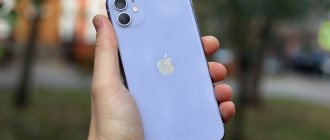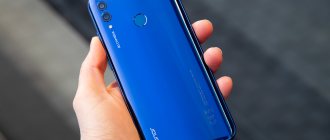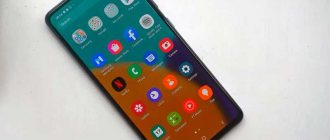Motorola Defy (2021) is the revival of the rugged Moto smartphone after 11 years. The 2010 Defy had an unusually strong body, and the 2022 model boasts some of the same strength characteristics.
Moto Defy (2021) was created together with the British company Bullitt Group, specializing in shock-resistant smartphones. This entry-level device has received a military protection rating - MIL-STD-810G. Unfortunately, apart from reliability, the smartphone is nothing else impressive: we get a 720p LCD display, a Snapdragon 662 processor and a 48-megapixel main camera lens.
For a phone costing 30 thousand rubles, the characteristics are really weak, apparently, you have to pay for durability, and a lot. I tried to find out what else Motorola offers us, and I will share my impressions in the review.
Specifications Motorola Defy (2021)
| Screen | 6.5 inch IPS, resolution 1600×720 pixels, 270 ppi, 20:9, screen-to-body ratio ~ 76.8% |
| CPU | Qualcomm Snapdragon 662 (11nm), octa-core (4x2.0 GHz Kryo 260 Gold + 4x1.8 GHz Kryo 260 Silver) |
| Graphic arts | Adreno 610 |
| RAM | 4 GB LPDDR4 |
| Inner memory | 64 GB, expandable via microSDXC (shared SIM slot) |
| System and software | Android 10 |
| Main cameras | 48 MP, f/1.8, (wide), PDAF + 2 MP, f/2.4, (macro) + 2 MP, f/2.4, (depth) |
| Front camera | 8-MP, f/2.2, 1.12 µm |
| Video | Main and front camera: 1080p at 30 fps |
| Communication and Connection | Wi-Fi 802.11 a/b/g/n/ac, dual-band, Wi-Fi Direct, hotspot, Bluetooth 5.0, A2DP, LE, GPS with A-GPS, NFC, FM radio |
| Net | GSM/HSPA/LTE |
| Degree of protection | IP68, MIL-STD-810G |
| Sensors | Fingerprint (rear), accelerometer, gyroscope, proximity, compass |
| Battery | Li-Po 5000 mAh, non-removable, fast charging 20 W |
| Connectors | USB-C 2.0, 3.5 mm |
| Materials | Front Gorilla Glass Victus, plastic frame and back cover |
| Case colors | Black green |
| Dimensions and weight | 169.8×78.2×10.9 mm, 232 grams |
| Price | 30 thousand rubles |
Middle class
Moto G9 Plus
- Processor: Qualcomm Snapdragon 730G
- Screen: 6.8 inch, 2400 x 1080
- Cameras (main/front): 64+8+2+2 MP / 16 MP
- Memory (RAM/built-in): 4/128 GB
- Battery: 5000 mAh
Price: from 19,000 rubles
Motorola Moto G9 Plus is an improved version of the mid-range G9 model. The smartphone is the top ninth version of the “G” series, which is technically superior to its earlier “brother” Moto G9 Play. Considering the entire list of characteristics, we can safely say that the smartphone belongs to the middle segment. But is this the case in practice?
The main camera here is represented by four modules at once, which is the basic set of almost any smartphone vying for a place in the middle segment. The wide-angle lens with a resolution of 64 MP is designed for shooting in almost any conditions, since in addition to regular shots it allows you to take frames with a wider image capture. And if you still can’t fit all the faces and other objects in the frame, an “ultra-wide” lens with a resolution of 8 MP and a viewing angle of 118 degrees will help. You can photograph small objects on a large scale thanks to the 2 MP macro module, and a depth sensor with the same resolution will allow you to blur the background almost without error and improve the overall picture. In general, the cameras on the G9 Plus may even be a little surprising, since usually you don’t expect the best sensors from a phone under 20 thousand, but here everything is not bad with shooting in both good and low light. Photos with excellent detail, there is an HDR mode, recording in 4K 30fps.
The G9 Plus is powered by a powerful mid-range Qualcomm Snapdragon 730G processor, where the “G” in the name stands for increased gaming performance and better 3D graphics performance. Another nice thing was that there are fairly fast drives for both RAM and internal memory installed on board, as they show excellent results in synthetic tests. There are no problems with performance and everything is at its best for its level. And thanks to a fairly clear LTPS screen, watching movies or gaming is even more enjoyable. The battery is set to 5000 mAh.
Advantages:
- Gaming processor.
- Good cameras.
- Capacious battery.
- TurboPower fast charging.
- NFC module.
Flaws:
- There may be problems with the stability of the mobile signal.
- Low display brightness reserve.
Moto G8 Plus
- Processor: Qualcomm Snapdragon 665
- Screen: 6.3 inches, 2280 x 1080
- Cameras (main/front): 48+5+16 MP / 25 MP
- Memory (RAM/built-in): 4/64 GB
- Battery: 4000 mAh
Price: from 25,700 rubles
Like its predecessor, the Moto G8 Plus is an improved version of its earlier 8-series sibling. Changes for the better affected the cameras, which received much better sensors, and the screen. Also included in the updated model is an NFC module, which today is a must-have item for many when choosing a smartphone. Otherwise, as far as the battery, processor and many other things hidden in the case are concerned, everything remains unchanged. And although compared to the new G9, the model is not so fresh to buy, it is still worth paying attention to.
On the back of the body, which is made entirely of plastic with special splash protection, there is a system of three cameras: main, ultra-wide-angle and macro (16+8+2 MP). An ordinary user, seeing three modules, will most likely be impressed, but in fact, everything here is not as cool as we would like - marketing. The quality of photos and video recording leaves much to be desired, especially in low light conditions. The camera lacks dynamic range, which is why some areas in the pictures are overexposed or, conversely, darkened. Detailing is also quite mediocre. But for social networks and users who are not picky about the camera, the smartphone is quite suitable. The front camera here has a resolution of 25 MP and is located in a special teardrop-shaped cutout. And yet, the photo capabilities of the model cannot be considered a disadvantage, given the price segment in which the G8 Plus is located.
Inside there is an 8-core mid-range Qualcomm Snapdragon 665 processor. This is a chipset that can handle any basic tasks and heavy games at medium-low settings. It won’t be enough for more, since the chipset was announced back in 2019 and has already positioned itself in the mid-range. There won't be any lags when working with applications, but you need to keep in mind that the processor is far from the most powerful. The battery has a “standard” capacity of 4000 mAh, which is fully charged in about 100 minutes and, taking into account well-optimized firmware, the device can operate on a single charge for about 2 days.
Advantages:
- Availability of NFC module.
- High-quality stereo sound.
- Battery life.
- Good microphones.
- Pure Android.
Flaws:
- Stainless plastic case.
- Combined tray for SIM cards and memory card (2 or 1+1).
Buy
Moto G8 Power
- Processor: Qualcomm Snapdragon 665
- Screen: 6.4 inches, 2300 x 1080
- Cameras (main/front): 16+8+8+2 MP / 16 MP
- Memory (RAM/built-in): 4/64 GB
- Battery: 5000 mAh
Price: from 14,700 rubles
The latest smartphone in this category is the Moto G8 Power. This is a simple and affordable device that boasts a capacious battery, a standard set of cameras, fast charging and a good processor for this price range. Unlike the “Plus” version, here we get characteristics closer to the budget segment, although the device still cannot be called a clear budget product.
Externally, the model is almost identical to the previous one and the cameras are located in the same place, so it is quite difficult to distinguish between “Plus” and “Power”. The body is also made of plastic, although the side frame is metal. According to Motorola, the cover has a special water-repellent coating that protects the smartphone from splashes. The rear camera is a system consisting of a main, wide-angle and telephoto lens, as well as a macro module. The pictures are of quite high quality and have good color rendition, although in some scenes the red color may fade into pale shades. There are no complaints about photographs taken with wide-angle and macro modules; they are of quite “good” mid-budget quality. But when you zoom in, sometimes photos lose sharpness and noise appears—the zoom here is mediocre. You can take good selfies with the 16 MP front camera. There is also a beauty mode.
The “heart” of the device is the eight-core single-chip Qualcomm Snapdragon 665 system, already familiar to us from the previous model. This processor will cope with basic tasks without any problems: surfing in browsers, watching movies and streaming video online, working with heavy applications and various social networks, undemanding games. Heavy projects like PUBG Mobile and so on can also be launched here, but at medium-low graphic settings, otherwise serious drops in FPS will be observed. In general, if you like to play at maximum speed, the G8 Power is not the best option. The onboard memory is sufficient for 2022 at a minimum: 4 GB of RAM and 64 GB of ROM. All elements are powered by a capacious 5000 mAh battery.
Advantages:
- Battery life.
- Pure Android.
- Supports 2 SIM cards.
Flaws:
- Stainless plastic case.
- Dim screen.
- No NFC.
Buy
Design and appearance
The 2015 Moto X Force and 2022 Moto Z2 Force were the company's attempts to make a shock-resistant smartphone with a modern design, but the same cannot be said about the Motorola Defy (2021).
The appearance of the device immediately indicates that it was created for the most extreme conditions. The Defy's dimensions are larger than those of the largest flagships, like the Sony Xperia 1 III, and with a weight of 232 grams, the Moto smartphone is heavier than the Samsung Galaxy S21 Ultra. Although the thickness is not small, the camera module is flush with the back cover.
The case protection is provided by TPU material, although it does not look very attractive, it does its job perfectly. The back cover is covered with a ribbed rubber layer, providing a more comfortable grip. There is a hole for a lanyard in the lower left corner, and the corners are rounded, which provides additional protection in case of falls. The body can be safely washed with soap or wiped with a disinfectant.
Among other interesting features of the Defy (2021), I note a 3.5 mm headphone jack on the top edge and a fingerprint scanner on the back. On the right side of the case you will also find a programmable key, configurable through the Mototalk application.
Which Moto lineups are hot in 2021?
All Moto smartphones can be divided into 5 lines:
- Z are top-end devices with an interesting feature in the form of additional Moto Mods, which attach to magnetic connectors on the back of smartphones.
- X are pre-flagship smartphones with the ability to update to the latest version of Android.
- G - average level with optimal characteristics.
- E - budget devices with all the necessary functionality.
- C - the cheapest Moto smartphones for very modest users.
It should be noted that due to the not very successful past years, the company's sales have decreased, which has caused a number of speculations and rumors about the demise of the brand. As of today, operations have not ceased, but the number of products has been significantly reduced. At the moment, out of 5 lines, only 2 remain: “G” and “E”. Flagship devices may be released under the auspices of the new “Edge” and “Razr” lines.
Smartphone protection
The protection of the Motorola Defy (2021) is really well implemented. The smartphone can withstand a drop from a height of 1.8 meters onto a concrete surface, and only a barely noticeable mark will remain on the body.
This is not surprising - the Defy has military-grade MIL-STD-810G protection, which means that the device has passed multiple tests and will withstand low or high temperatures, heavy shocks and extreme conditions. Moreover, Motorola and Bullitt also took care of the reliability of internal components. The smartphone comes with a reinforced board that is resistant to falls.
Of course, there is also a degree of protection against water and dust - IP68, which means that Defy is completely protected from dust, sand and can withstand immersion under water to a depth of 1.5 meters for 35 minutes. This level of protection is often found in ordinary smartphones, but not in the segment up to 30 thousand rubles.
Another advantage of the model that Motorola focuses on is its ability to withstand extreme temperatures. Even if you spill boiling water on your gadget, just wipe it off and continue using your phone as if nothing had happened. According to the manufacturer, the smartphone will withstand constant temperature changes from -25°C to 75°C for 30 minutes - this is truly impressive.
Conclusion
For convenience, the information on the above models is structured and summarized in a table, which you can familiarize yourself with:
| Model | Motorola Moto Z Force gen.2 | Motorola Moto Z Play | Motorola Moto Z2 Play 64GB | Motorola Moto X gen 2 16GB | Motorola Moto E5 Plus 32GB | Motorola Moto G5s 3 32GB |
| RAM, GB | 4 | 3 | 4 | 2 | 3 | 3 |
| Internal memory, GB | 64 | 32 | 64 | 16 | 32 | 32 |
| Screen size, inches | 5.5 | 5.5 | 5.5 | 5.2 | 6 | 5.2 |
| Main camera, MP | 12+12 | 16 | 12 | 13 | 12 | 16 |
| Front camera, MP | 5 | 5 | 5 | 2 | 8 | 5 |
| Battery capacity, mAh | 2750 | 3510 | 3000 | 2300 | 5000 | 3000 |
| Weight, grams | 140 | 165 | 145 | 140 | 200 | 157 |
| Cost, rubles | 31900 | 20000 | 19500 | 16000 | 11500 | 9700 |
The popularity of Motorola smartphone models is unconditional, because it is a brand with history, and an entire generation has grown up on its phones. Today, flagship smartphones from Motorola are in no way inferior to models from other top manufacturers, while they retain their individual features that distinguish them from their competitors. It is worth noting the availability of devices, their extensive functionality, as well as their high quality.
Of course, it’s up to you to decide which model is better to buy - but, albeit small, the Motorola model range in Russia includes many attractive options for the combination of price and quality, and even an unusual design. Therefore, whatever your selection criteria, the American-Chinese brand will find something to surprise and delight you with.
Motorola smartphones have a lot of advantages, and all the identified disadvantages are largely far-fetched and subjective, since they relate to issues of convenience and personal preferences. If you haven’t found “your” device among those reviewed, you can choose another option on the official Motorola website or on Yandex.Market, where more than 20 different models from different price segments are on sale.
The screen is also protected
Anyone who has repeatedly dropped a smartphone on a hard surface knows that the screen is the most sensitive part of the device. Therefore, the front of the Motorola Defy is protected by 0.7mm thick Corning Gorilla Glass Victus.
Even if your gadget falls on a concrete surface, there will not even be scratches left on the display. That's what military-grade protection means. But, in terms of all other characteristics, the screen is not impressive at all. This is a 6.5-inch LCD panel - although the diagonal is large for a shock-resistant smartphone, LCD for a smartphone for 30 thousand today seems like a disadvantage.
The brightness is also lacking, which is a clear disadvantage for a phone designed for use in the most extreme conditions. But the main problem of Defy (2021) is the resolution of 1600x720 pixels, that is, HD+. This is not enough even for a smartphone for 15 thousand rubles, not to mention 30 thousand. Moreover, the protected AGM X3 and Doogee S88 Pro already have Full HD+, so there is no justification for such a decision.
Although the refresh rate is 60 Hz, it is unlikely that anyone will buy a rugged smartphone for gaming and watching movies, so this is not a serious drawback here. On a positive note, the display's colors are accurate, with the low resolution not being noticeable when navigating the interface.
Moto Defy Cameras
As is the case with hardware, the cameras of the Motorola Defy (2021) are very reminiscent of the counterpart in the Moto G9 Play.
We get a 48MP main sensor, there is no ultra-wide-angle or telephoto lens here. There is only a 2 MP depth sensor and a macro lens with a modest 2 MP resolution. The front camera has an 8MP resolution, so overall the set isn't too impressive.
The main lens is not the worst in practice, although you expect more from a smartphone at this price. If you enlarge the image, low detail is noticeable - it is better to view the photos on a smartphone screen. Good quality photos can only be taken in good daylight.
Macro lenses on smartphones are rarely useful, and the Moto Defy (2021) is no exception. I advise you to shoot at close range with the main lens - the final photos will be more successful.
Flagships
Motorola Razr 5G
- Processor: Qualcomm Snapdragon 765G
- Screen: 6.2 inches, 2142 x 876
- Cameras (main/front): 48 MP / 20 MP
- Memory (RAM/built-in): 8/256 GB
- Battery: 2800 mAh
Price: 119,990 rubles
The selection of the best Motorola smartphones opens with the unusual Razr 5G model. The device is distinguished by the presence of 2 screens, one of which is bendable, support for fifth generation networks (5G), rare OLED matrices for mobile devices (in both screens) and a large price tag of 120 thousand, which immediately catches the eye. Based on other characteristics, it is difficult to say whether the cost justifies this filling. Let's try to understand in more detail the main “internals” of the smartphone and answer this question.
The main camera has a single 48 MP module. There is no wide-angle lens, no macro sensor, no depth sensor, and certainly no telephoto. Perhaps the very design of the foldable screen did not allow the company’s engineers to come up with another, more technologically advanced and modern solution, because even outright budget devices today have at least a double or triple camera. The quality of both the front and rear cameras here is similar to those installed in middle-class smartphones. The Razr 5G is far from other flagship devices in this regard.
There are no surprises in terms of performance either. “Under the hood” there is a fresh 8-core mid-high-level Qualcomm Snapdragon 765 5G processor, which is quite capable of “running” any applications or games at maximum graphics settings. And the memory supply here is decent: 8 GB of RAM and 256 GB of permanent storage. And yet even this is not what you expect from a device at this price. Obviously, the whole highlight of the clamshell is only in its bendable OLED screen. Even the battery installed was not the most capacious - only 2800 mAh, which is slightly below average.
Advantages:
- Gaming processor.
- Bendable and additional OLED screens.
- Support 5G, NFC.
Flaws:
- High price.
- Mediocre cameras.
- Weak battery.
Motorola Edge+
- Processor: Qualcomm Snapdragon 865
- Screen: 6.7 inches, 2340 × 1080, 90 Hz
- Cameras (main/front): 108+16+8 MP (+ToF) / 25 MP
- Memory (RAM/built-in): 12/256 GB
- Battery: 5000 mAh
Price: from 70,000 rubles
In second place is Edge+. Unlike the Motorola Razr 5G clamshell, this is a much more interesting smartphone, which in all respects fits the description of a full-fledged flagship. It has a top-end processor, a large amount of memory, good cameras and a capacious battery. And yet, the main feature of the smartphone and its highlight is the bright 6.7-inch diagonal AMOLED screen, bent at the edges by 90 degrees. That is why the device received such a name, and the screen itself. This form factor allows you to remove the feeling of frames and make the image limitless.
On the back of the aluminum body is a triple camera + 3D ToF sensor. The main module has a resolution of as much as 108 MP. To help it, 2 lenses were added: a 16 MP ultra-wide-angle and an 8 MP telephoto with 3x optical zoom. When announcing the model, the manufacturer himself mentioned how well he worked on the cameras. And indeed, the pictures turn out to be of high quality, both on the main module and on the ultra-wide-angle and telephoto, especially in good lighting. The photographs do not have any obvious flaws, the shutter speed is selected correctly, and the colors are accurately and naturally reproduced. Much attention was paid to the advanced stabilization system when shooting video.
The device is powered by an 8-core Snapdragon 865 chipset from Qualcomm. Among all the manufacturers of single-chip systems that are used in Android devices today, chips from Qualcomm are the most powerful and priority for choice. The 865th “dragon” is actually the flagship chip of 2022, so it can provide you with smooth operation of the system in any conditions for the next 2-3 years. Edge+ is powered by a 5000 mAh battery, the energy reserve of which is enough for at least 1.5-2 days of active use.
Advantages:
- Powerful processor.
- Large curved AMOLED screen 90 Hz.
- There is 5G, NFC.
- Battery life.
Flaws:
- Slow charging.
- Only 1 slot for SIM card.
Buy
Software
Motorola Defy (2021) runs on the previous version of Android 10 OS, which is strange - Moto G50 and Moto G10 already have Android 11.
Apparently, this will change with the next update, because for Defy Motorola guarantees us two years of full security updates. But while the smartphone is far behind modern standards.
But the version of the Android system here is practically unchanged; Motorola is famous for adding only a few convenient changes and functions. I found the Moto Actions gestures especially useful: wave your smartphone lightly to turn on the flashlight, or twist twice to launch the camera.
Component Performance
When actually using the Motorola Defy (2021), it sometimes feels like Moto took the old G9 Play and asked the Bullitt Group to add a rugged case to it. The reason is that the hardware of these models is the same.
Here we get a Snapdragon 662 processor and 4GB of RAM. Of course, the performance is not the highest. In Geekbench 5 multi-core mode, the device scores only 1401 points, which is worse than the Realme 8 Pro and OnePlus Nord CE 5G. The same goes for graphics - in the GFX Car Chase test, the Defy only achieves 13 fps.
On the other hand, weak processors on high-impact smartphones are a common occurrence. The Doogee S88 Pro mentioned above also runs on the not very powerful MediaTek Helio P70. You can play on the Motorola Defy, although it is one of the weakest phones in its price segment. The PUBG game will run fine only on minimum graphics settings.
If gaming is more important to you than protection, I recommend choosing the Poco X3 Pro. 64 GB of internal memory is also not impressive - all competitors have at least 128 GB. At least there's room for a microSDXC memory card, so the storage can be expanded.
About the manufacturer Motorola
Motorola is one of the five hundred largest American companies, and is currently divided into two independent divisions and dissolved.
In 1993, Motorola appeared on the Russian market, where it carried out its activities relatively successfully until 2011, after which it left the country.
In the same year, Motorola's smartphone division was acquired by the largest Chinese company Lenovo.
Under the auspices of Lenovo, the Motorola brand reappeared on the Russian market in 2016, and already rather forgotten Moto smartphones began to appear in stores again. The Motorola website has also started functioning, where all currently available smartphone models are presented and comprehensive information on them is provided.
Which company is better to buy the device is up to the user to decide, but Motorola can be safely recommended, since there is no doubt about the quality of Lenovo smartphones.
Battery autonomy
A shock-resistant smartphone is of little use if it is unable to work for at least a day on a single battery charge. Fortunately, the Motorola Defy has a capacious 5000 mAh battery inside.
If you use your rugged Motorola phone sparingly, you can expect up to two days of use. The PCMark test shows a result of 17 and a half hours. For example, Poco F3 scored only 14 and a half hours in this test, and Realme 8 Pro scored less than 13. Although a smartphone with a 720p display should not quickly consume energy.
The rugged Defy (2021) is charged via the included 20W adapter. Naturally, the rate of energy recovery is not very high - in half an hour the battery is replenished by only 30%.
Other Edge 2022 improvements
Motorola made two more notable modifications. First, the developer has replaced the dinky in-display fingerprint sensor found on last year's model with a capacitive scanner built into the power button located on the side of the smartphone.
Motorola has also moved the camera cutout to the center of the screen, which provides more natural selfies and comfort during video calls. But the biggest impact is the switch to a different fingerprint scanner format.
After a week of testing, we can conclude that the sensor works more than well. It responds quickly and accurately to your touch, and we didn't have to register the same fingerprint multiple times to get it to work effectively. This is one of the issues we encountered while testing last year's Moto Edge.
Another highlight of the Moto Edge is its battery life. Motorola says you can get up to two days of battery life from the built-in 5,000mAh battery. We found the battery life claims to be true, but only if you limit the frame refresh rate to 60Hz. In our battery test, which uses 30 hours of footage, it lasted 19 hours and 45 minutes. With this, the Motorola Edge 2022 joins the company of the most powerful we've tested . Only the Google Pixel and Samsung Galaxy flagships showed better results, but it's worth noting that they are equipped with a more energy-efficient OLED display.
Motorola Defy (2021) alternatives and prices
The new Motorola Defy costs about 30 thousand rubles - which is too expensive, especially in comparison with the Moto G9 Play, which has almost the same characteristics and costs 16 thousand. However, for a shock-resistant smartphone, inflated prices are common practice.
When choosing among other secure phones, it is worth noting the CAT S62 Pro (also made by the Bullitt Group), although it costs 60 thousand rubles. It has less performance, but much better functionality.
In terms of price-quality ratio, AGM X3 would be a better option. But it makes sense to buy a shock-resistant smartphone only if you are constantly in extreme conditions, risking breaking the device. Otherwise, there are many better options.
For example, Poco F3, which has a much better display, performance and cameras. Or Realme GT Neo 5G, which has 5G support in addition. However, both devices, even if dropped from a small height onto a hard surface, risk being hopelessly broken, so it all depends on your priorities.











